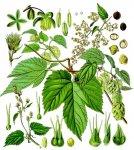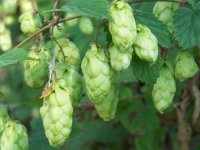Common hops
Humulus lupulus L.
Botanical characteristics. The family is mulberry. Perennial herb creeping plant. The stem is long, curly, tetrahedral, with sharp spines, hollow inside. Stems of hops cling to the vertical supports, the top of the shoot performs circular movements (one turn at 2 hours 8 minutes). There is a fleshy rhizome, in the spring it can be eaten. Leaves are long-petioled, three-five-lobed. The plant is dioecious, blooms in July-August. Male flowers are small, green, collected in the inflorescence. Pestle flowers are represented by ears of cones. Bracts have glands containing "lupulin" - the main healing principle of hops. Fruits are small nuts, ripen in August-September.
Spread. It grows in the European part of the country, as well as in Siberia. Prefers riverine thickets, ravines, raw deciduous forests. Cultivated as a food, medicinal and ornamental plant.
Used parts of the plant.
Ripe cones.
Hop cones contain essential oil (1-3%), consisting of gumulene, luparone, luparenol and isovaleric acid, aliphatic terpenes, diapentene (30-50%), aliphatic terpenic alcohols (geraniol and linalool) and esters of mycenol alcohol (30- 40%), resinous substances in a considerable amount, bitterness (up to 5%) and phytoncides.
Application.
The plant has a pronounced soothing effect and is taken with neuroses, insomnia, hysteria, climacteric complaints, with neurocirculatory dystonia according to the hypertonic type.
Hops are bitter, used for asthenia and gastritis as a restorative, improving appetite and digestion means. Cones are sometimes added to the fees prescribed for the treatment of various diseases of the liver, kidneys and bladder, given its anti-inflammatory, choleretic and diuretic effects.
Hop preparations are indicated for painful menstruation, with nocturnal pollutions and excessive sexual excitability; It is added to the charges for metabolic disorders.
Preparations from the plant have analgesic, anti-inflammatory and spasmolytic effects and are therefore effective in cystitis and urethritis.
In folk medicine, hop has long been used as an external remedy: in the form of ointments or poultices to relieve pain and inflammation with gout, rheumatism, abscesses and bruises. With seborrhea, the head is washed with infusion of cones. A pillow filled with fresh cones of hops helps with insomnia.
Contraindications. Hops are a poisonous plant. In case of an overdose, there may be a general malaise, headache, nausea, vomiting, pain in the heart and shortness of breath.
Preparation.
Infusion for internal use: 2 teaspoons of cones insist with 1 glass of boiling water; Take in 3 divided doses (daily dose).
Infusion for external use: 2 tablespoons insist with 1 1/2 cups of boiling water.
Powder of cones take 1/2 teaspoons 3 times a day for 20-40 minutes before meals, washed down with water.




Comments
Commenting on, remember that the content and tone of your message can hurt the feelings of real people, show respect and tolerance to your interlocutors even if you do not share their opinion, your behavior in the conditions of freedom of expression and anonymity provided by the Internet, changes Not only virtual, but also the real world. All comments are hidden from the index, spam is controlled.